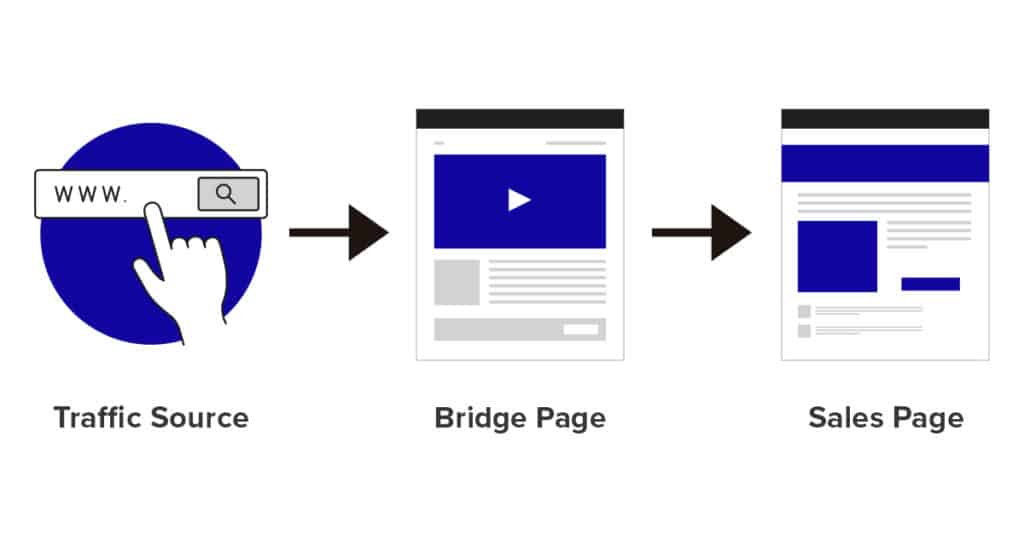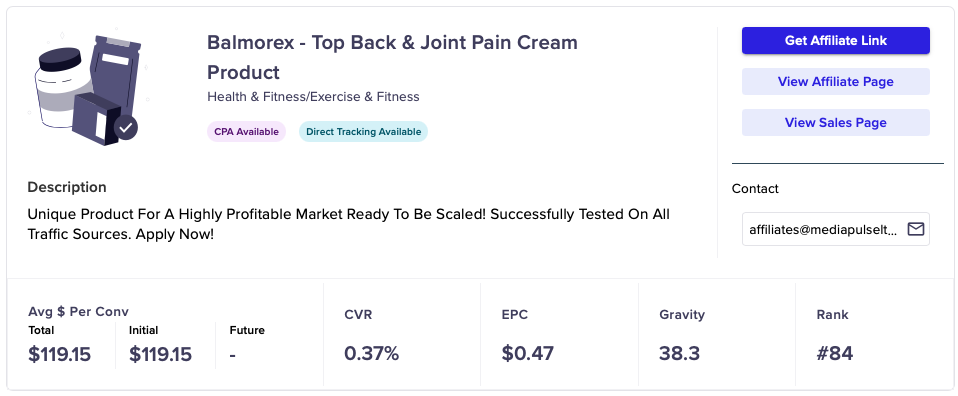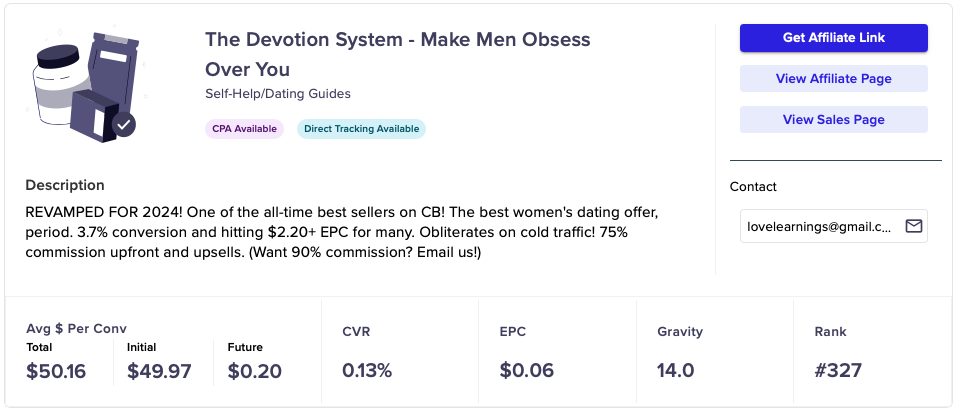You came here to answer one burning question: Is affiliate marketing profitable?
The short answer is yes, affiliate marketing can be wildly profitable in 2025. The longer, more in-depth answer starts with “it depends.”
In this article, I’ll break it down from ClickBank’s perspective as a top affiliate network, diving into the actual profitability of affiliate marketing across 5 types and revealing how to maximize your own profits as an affiliate!
Let’s dive in.
Is Affiliate Marketing Profitable?
Affiliate marketing can certainly be profitable, and it’s also relatively easy to generate a lot of sales through scaled channels like paid media and email marketing.
However, as any successful business owner will tell you:
Sales ≠ Profits
In business, you calculate profitability with the following formula:
Revenue – Expenses = Profit
For example, say I’m an affiliate and it costs me $100 to promote an offer with a Meta Ads campaign. If I make $150 in affiliate commissions, then:
$150 – $100 = $50 Profit
Simple enough!
Now, in my role as Senior Content Manager at ClickBank, I have personally chatted with dozens of ClickBank Platinum and Diamond clients who generate hundreds of thousands or even millions of dollars in sales per year on our platform!
At ClickBank, we’re actually the merchant, which means we process the transaction for each sale – see my guide on how ClickBank works for more details. But the bottom line is, ClickBank can see how many total sales are generated through our platform for both affiliates and sellers.
With that said, we have NO visibility into our clients’ business expenses.
Seller Profitability
On the seller side, getting top affiliates to promote your offer might mean paying out a 50%, 75%, or even 90% commission per sale, which takes a huge chunk off the top – and on the affiliate side, those top affiliates often use paid ads to drive traffic, which has a high fixed cost attached to it.
Anecdotally, I’ve heard that many ClickBank sellers just try to break even with affiliates, meaning they’re paying affiliates to bring them brand-new customers for FREE (still a great deal compared to most options for acquiring a new customer).
From there, they can continue to sell more of the same offer, promote other internal offers, or promote external affiliate offers to their email list to generate a profit.
Affiliate Profitability
And for affiliates, profit varies wildly, but a return-on-ad-spend (ROAS) of 1.3 is about the bare minimum that makes it worth it – in other words, for every $1 they spend, they can expect $1.30 back, or a profit of $0.30.
Just keep in mind, there are more costs in business besides affiliate commissions or ad spend, including software subscriptions, web hosting, labor, office space, professional services like accounting, and of course, taxes!
With all of this nuance in mind, let’s take a look at the profit potential for each of the most popular affiliate types!
Profit Potential by Affiliate Type (5 Options!)
At ClickBank, we’ve identified five common types of affiliate marketing on our platform with the highest potential for success.
Of course, no matter which one you choose, there’s always a tradeoff between time and money. Let’s talk through the most common affiliate types and consider the profit potential of each one!
1) Media Buying
Media buying involves using pay-per-click (PPC) ads on popular, proven platforms. These ads usually send traffic to a landing page (sometimes called an affiliate bridge page), and from there, through an affiliate tracking link to the offer owner’s pitch page to make the sale right away.

Media buying is the fastest method of driving affiliate traffic and it has the highest earning potential, because you’re literally paying to get your message in front of as many potential buyers as you can afford to reach.
You can run ads with popular paid traffic sources like Meta Ads (Facebook or Instagram), YouTube Ads, Google Ads, and native advertising (Taboola, NewsBreak, etc.).
In the grand scheme, you won’t need to spend as much time and money creating “content” for paid like you would for organic traffic sources, and you can theoretically start seeing profits in just a week or two, assuming you have the right combination of ad creative, copy, and landing page for your target audience.
How Profitable is Paid Media?
- Startup cost: ~$3,000 (to test + scale)
- First sale timeline: 1–2 weeks
- Avg. profit margins: 20-30%
- Break-even ROAS target: 1.0 (aim for 1.3+)
- Great ROAS target: 2.0+
So, is affiliate marketing profitable for media buyers?
It definitely can be, but there are some caveats!
While running paid media allows you to see sales as an affiliate quickly, it also costs the most of anything on this list to implement. In fact, one of our Platinum clients, Ernesto Mejia, recommends a budget of $3 to 5k per month for affiliate marketing success with YouTube Ads – that’s clearly a big investment.
When it comes to return on ad spend (ROAS), you only profit if your ROAS is greater than 1 – in other words, if you’re earning more in affiliate commissions than you spend to run ads. (And of course, you also have to factor in your time, the cost of software subscriptions, and any other miscellaneous expenses that go into your paid campaigns!)
I know that sounds intense, but the most successful affiliates on ClickBank are all media buyers. I’ve interviewed a long list of ClickBank Platinum affiliates (those who generate at least $250k in sales on the platform in one year). Most of them hit that $250k milestone because of the scale they can achieve running paid traffic – primarily through Meta or YouTube Ads, with native ads coming in as another strong paid alternative right now.
Obviously, if you earn more than you spend on ads, then you can make a profit – but margins can be tight. (Between you and me, I’ve heard one ClickBank client say they basically break even on ad spend and all of their upside is credit card reward points!).
That’s why paid is the highest-risk, highest-reward path for affiliate marketing.
Media Buying Tips to Become a Successful Affiliate:
- Start with the Right Product: Focus on affiliate products with high-converting sales pages, typically featuring quality video sales letters (VSLs). The first few pages of top affiliate offers in ClickBank’s marketplace tend to perform well with cold traffic from paid ads.
- Start Small: Test the waters before you dive in. You can gather a lot of data without overspending. (And even after you’re successful with an offer, be prepared to keep testing other offers so you can optimize your spend for what’s working.)
- Metrics Matter: What gets measured gets improved. You can’t know how you’re doing if you don’t measure results. Keep an eye on your ads, track performance, and see if you’re actually getting conversions. Test new targeting, ad networks, copy, and landing pages, and ditch any ad or ad sets that aren’t performing.
2) Blogging
Blogging is a time-tested method for affiliate success. Much of the internet was built around publishing written content on a website and then monetizing it with affiliate products.
Building an affiliate website means you can focus on a topic for a specific audience that interests you and promote relevant products to them!
How Profitable is Affiliate Blogging?
- Startup cost: ~$100-300 (domain, hosting, theme)
- First sale timeline: 2-6 months
- Avg. profit margins: 60-85%
- Traffic threshold for $500+/mo: ~10,000 monthly visitors
- Monetization Stacking: Combine with display ads on Ezoic or Mediavine to boost earnings by 50%
Is affiliate marketing profitable for bloggers?
Absolutely, if you stick with it for the long term! You do need to learn key skills like search engine optimization (SEO), how to build a website, writing, and research. These days, the secret sauce to blogging is providing real value that readers can’t easily find elsewhere (either from other human creators or from AI chatbots like ChatGPT).
But when you get it right, affiliate blogging can be a real money-maker!
The numbers speak for themselves. Content marketing (including blogging) is a $400 billion per year business. Almost half (47%) of buyers consider blogger/vlogger recommendations when shopping. Over a third (34%) have made an unplanned purchase because of high-quality, persuasive content.
The trade-off? It can take a long time to learn the ropes, publish enough content to drive traffic, earn Google’s trust, boost your site’s domain authority, and become a trusted name in your niche.
Once you have a decent amount of content and are driving thousands of search visitors per month, you can earn passive income for years to come. In fact, this is my chosen method of affiliate marketing, which I’ve used to generate affiliate sales with a popular digital product on ClickBank:

But just as a personal note here, it seems more and more likely that affiliate blogging on its own isn’t a self-contained business model, because Google isn’t giving pure content sites a lot of love anymore. However, affiliate blogging still works great when paired with other “free traffic” channels like YouTube, Pinterest, Instagram, and email.
The best thing about affiliate blogging is that it’s so low-cost. Aside from web host expenses and any outsourcing of content creation, your fixed costs are minimal – so whatever revenue you can generate is mostly profit!
Affiliate blogging is a low-risk, moderate time investment, and high-potential profit option. If you’re patient and determined, you can see tremendous and compounding success as an affiliate blogger!
Blogging Tips to Become a Successful Affiliate:
- Manage Expectations: Don’t rush it, put in the time and effort, and don’t expect to get rich overnight. Blogging is a long game – but momentum builds on itself.
- Choose Carefully: Pick a niche you truly enjoy reading, writing, and thinking about. Otherwise, it’ll be much harder to build an audience’s trust and they won’t be persuaded to follow your affiliate product recommendations.
- Be Trustworthy: Don’t just promote any product with a decent commission. Pick products you believe in that you truly think will help your readers.
3) Influencer
Influencers are popular public figures on social media. The most prominent example of influencers is the Kardashians, who built up a strong reputation for trend-setting and high-quality, luxury taste. When one of the Kardashians uses a product, it makes waves and gets people talking (and buying).
Of course, most people aren’t anywhere close to as famous or influential as the Kardashians, but even smaller influencers can make money promoting products to an engaged audience!
How Profitable is Social Media Influencing?
- Startup cost: $0-$500 (smartphone, Canva, link-in-bio tool, optional video gear)
- First sale timeline: 1-3 months (if starting from scratch)
- Avg. profit margins: 70-90% (unless you pay for editing or UGC creation)
- Follower threshold for $500+/mo: ~5,000-10,000 engaged followers
- Monetization Stacking: Combine with brand sponsorships or your own products to boost revenue
Is affiliate marketing profitable for influencers?
Yes, becoming an influencer has an earning potential ranging from decent to cha-ching, depending on audience size. And that’s the catch: You have to have an audience.
Unlike paid media or blogging, where there’s a built-in mechanism for reaching new people with your ad or article, social media influencing works best when you have a large group of people following you. This doesn’t mean you can’t get discovered or populate someone’s For-You Page with your posts on TikTok and Instagram, but influence is the name of the game when promoting affiliate products.
There’s almost zero chance of a lookie-loo who randomly sees your post or short video deciding to go to your link-in-bio, click through to a landing page, click your tracking link, and go on to buy something – not if they don’t already know, like, and trust you!
Instead, you need to naturally build an audience by creating engaging and/or helpful content over time. People need a good reason to follow you. Eventually, the more trust you have, the better your conversion rate will be with affiliate marketing (along with other money-making opportunities like brand sponsorships or sales of your own product).
While being an influencer requires a minimal financial investment, it does take a LOT of time! If you’re interested in being an influencer or already have an audience, this could be a great opportunity for you to monetize. However, if you’re looking for a simple side hustle to earn affiliate income, you should know how long it takes to master the social media game.
I’d recommend picking just one or two platforms covering the same format (i.e. short-form video, long-form video, or text) to master and get some traction.
Influencer Tips to Become a Successful Affiliate:
- Build an Audience Organically: You won’t attract an audience if all you do is promote products. You need a way to provide some value to grow your following.
- Be Authentic: Authenticity is key. Don’t promote products you don’t use or believe in. Every recommendation reflects back on you.
- Align Your Products and Audience: You need to understand who follows you and why. Make sure every product you promote accounts for that.
4) Email Marketing
Email marketing is an incredible opportunity for affiliate marketers, but it’s a little different from the other types of affiliate marketing on our list.
The first three affiliate types are end-to-end strategies you can pursue and still see success. But let’s face it: you can’t just be an email marketing affiliate, right? Who would you email? How would you get those subscribers to opt in to your list?
The reality is, email serves as a great multiplier or amplifier for other affiliate marketing methods you’ve mastered.
For example, if you grow your email list as a blogger or influencer, you can use those emails to send newsletters with info about what you’re into right now. You can talk about your main focus, what software or equipment you love, and what products you use.
How Profitable is Email Marketing?
- Startup cost: $50-$300 (ESP, landing page builder, lead magnet)
- First sale timeline: 1-4 weeks (if you already have a list – longer if building one from scratch)
- Avg. profit margins: 60-90% (email = low cost; list-building = higher cost)
- List size for $500+/mo: ~1,000-2,000 subscribers (depending on offer, CTR, send frequency)
Is affiliate marketing profitable for email marketers?
Yes, very profitable!
Email is a great way to promote products to a qualified pool of potential (or existing!) buyers. After all, if they gave you their email address, they likely have more devotion and/or trust than casual followers.
Email marketing is a pretty low-cost process, and it has the highest ROI of any marketing tactic. For every dollar you spend, you make $42 back. It doesn’t get much better than that.
Of course, email marketing isn’t free. If you have a large enough list, professional email service providers can cost you tens or even hundreds of dollars per month.
And as I mentioned earlier, you need a way to populate your email list with engaged subscribers. To do that as an affiliate, you’ll generally want to seed the list with an organic or paid traffic funnel, like so:

This may lower your conversion rate for initial sales, but it will allow you to market and promote to your audience later!
Email Marketing Tips to Become a Successful Affiliate:
- Provide Value: Just like with influencer marketing, you can’t just promote products and expect people to keep following. You need to provide value to receive value.
- Be Consistent, But Not Annoying: People subscribe to get regular updates. If you email once a month, they might forget they’re subscribed and why. If you email people three times a day, though, they’re probably going to unsubscribe out of sheer exhaustion. Iw times per week is usually a good balance.
- A/B Test: Email marketing is still marketing. Gather data, test different formats, copy, and CTA, track changes, and keep improving. Know your affiliate email marketing metrics!
5) Community Management
This can come in many forms, and while the term is unfamiliar to many people, the concept isn’t. Think Facebook groups, Slack channels, Skool communities, and Discord servers. As the name suggests, the idea is to create and manage your own community – but many people can find some success with existing communities they’re just members of.
Like with email marketing, community management tends to work best as a multiplier or amplifier rather than its own dedicated affiliate strategy. Running a community can have high costs, especially if it’s through paid online community platforms like Circle or Mighty Networks. But when successful, you got direct access to a group of loyal fans who will take your affiliate product recommendations very seriously.
I won’t lie – managing a community is a long-term game that’s tough to pull off. It takes a lot of time and energy to build and maintain a community like this, especially if you’re doing it all on your own. It requires not only original content, but also active interaction with your community.
How Profitable Is Community Management?
- Startup cost: $100-$500 (platform fees, branding, onboarding)
- First sale timeline: 1-3 months (if building a community from scratch)
- Avg. profit margins: 40-75% (depends on whether you charge for access or just use affiliate links)
- Community size for $500+/mo: ~100–300 engaged members
- Monetization Stacking: Combine affiliate promos with memberships, coaching, or other product sales.
Is affiliate marketing profitable for community managers?
It can be, but it takes a lot of work and a delicate touch!
And if you’re going to all the trouble to grow your own community, let’s be real: the most profitable way to monetize it is probably charging a membership fee.
Affiliate marketing makes for a fantastic revenue stream in your community, but you’re leaving money on the table if you don’t find other ways to monetize it: services, software, coaching, or your own products.
Community Management Tips to Become a Successful Affiliate:
- Build on a Solid Foundation: Build up a community on a specific topic or shared interest. This works best when you’re dialed in on a pain point you can solve for your target audience.
- Position Yourself as an Expert: Affiliate links work best when framed as informed recommendations from a trusted source.
- Don’t Overdo It: If you provide no value, all product links, people won’t stay.
Putting It All Together
So, now that we’ve looked at five different types of affiliate marketing and how profitable each one, what does the overall picture look like for affiliate profitability?
| Channel Type | Profit Margin | Why? |
|---|---|---|
| Paid traffic | 10-30% | High upfront cost; scale = leverage |
| Owned traffic (email, blog, organic) | 60-90% | Low marginal cost per sale |
| Hybrid (community, influencer) | 4-75% | High time investment or tools |
The biggest caveats when predicting affiliate profitability are skill level, scale, and product type.
1) Skill Level
First, a skilled blogger or email marketer can dramatically outperform an average media buyer affiliate in terms of profitability.
While the scale of paid media can help you reach meaningful profitability fast, every opportunity has the potential for incredible profits if you know what you’re doing!
That’s why skill level matters. Mastering your channel and understanding your audience is essential, no matter what type of affiliate marketing you’re doing!
2) Scale
Second, there’s a world of difference between profit margins and actual profit in absolute terms.
For example, if I make 100% on $10, that means I made $10 – meh.
If I make just 1% on $1 million, that’s $10,000. Nice!
If you apply this lesson to affiliate marketing, you can see how much scale matters.
There’s nothing wrong with having a social media account or a blog for fun, but if you want it to actually be worth your while, then you need to reach a certain threshold for these numbers to “math.”
Say you have 1000 blog pageviews per month, convert 0.5% of total visits to your blog into affiliate sales, and make $50 per commission. That means you can expect roughly five sales (or $250 per month) in affiliate commissions from your blog. If you pay $25 per month in expenses, you’ve got a 90% profit margin – but your total profits are only $225, which isn’t super interesting.
Now let’s scale that same scenario up, assuming your conversion rate and margins hold steady:
- At 10,000 views/month, you’d earn $2,250 in monthly profit
- At 100,000 views/month, that’s $22,500 in monthly profit
Same margin. Very different outcome.
Compare that to paid media. You may have just a 15% profit margin – but if you spend $1 million on ads that convert well, you’d pocket $150,000 on that investment. You should expect lower margins at higher scale, but it’s your absolute profits that really matter!
Actual profit is what pays your mortgage or buys you time and location freedom.
3) Product Type
Lastly, I want to point out that different channels lend themselves better to different kinds of products. Many of the top products on ClickBank are designed to convert on cold traffic from paid ads. This direct response approach is more transactional and less relationship-based.
The average payout per sale for those products is in the $120-150 range, which means you spend more, but also can expect more revenue with every commission you make – and you make a LOT of commissions when you can drive scale as a media buyer.

For organic traffic channels like a blog or social media, you’ll be looking at products that convert better when you’ve built up an audience – usually a digital product in a realm like business, dating, spirituality, or survival.
For this class of digital programs, $50 commission is more common of an unexpected payout.

Ultimately, you’re playing two very different games when you consider paid traffic versus organic traffic, and comparing the two is like comparing apples and oranges.
The profit potential is there in both cases, but you have to fully commit to playing that particular game in order to become as profitable as possible!
Affiliate Marketing Profitability Wrap-Up
We’ve covered a lot of ground in this post, but now, let’s go back to the original question: is affiliate marketing profitable?
The answer is yes!
If you do it right and don’t expect a get-rich-quick scheme that requires no effort, affiliate marketing can be extremely profitable! You just need to build up the skills and execute on your campaigns to achieve consistent income over time.
If you’re committed to putting in the work to be successful, ClickBank is a great starting point for your affiliate marketing journey. Be sure to sign up for a FREE ClickBank account now!
And to kick off your journey toward a profitable affiliate business, I recommend Spark by ClickBank, the official affiliate marketing education platform from ClickBank. In our quality free and paid traffic coursework, you’ll learn how to make your first $2,000 in just 90 days.
After that, the sky’s the limit…
Happy scaling!







